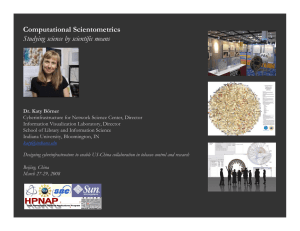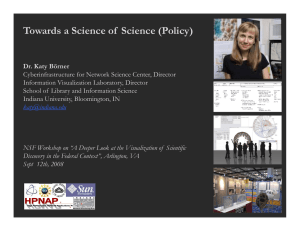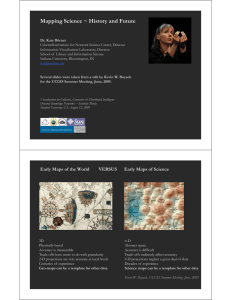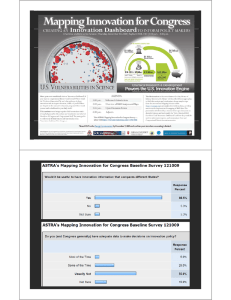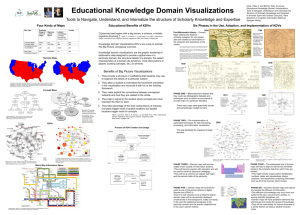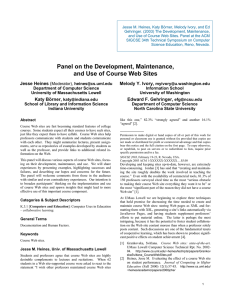Mapping, Illuminating, and Interacting with Science (sap_0116)
advertisement
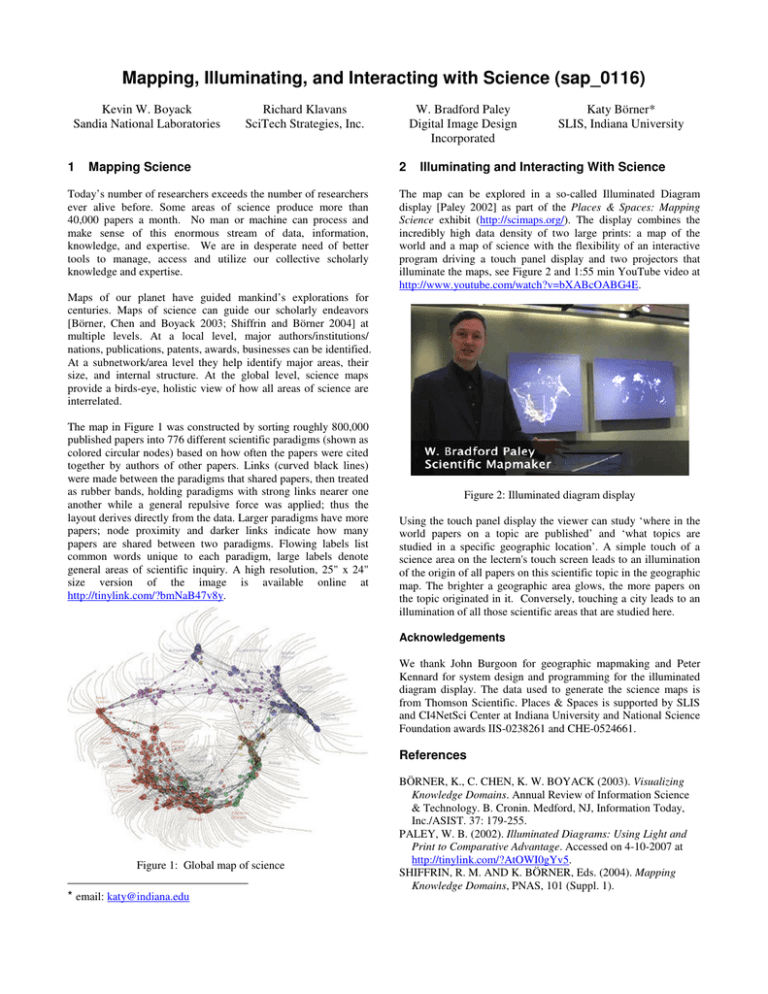
Mapping, Illuminating, and Interacting with Science (sap_0116) Kevin W. Boyack Sandia National Laboratories 1 Richard Klavans SciTech Strategies, Inc. Mapping Science1 Today’s number of researchers exceeds the number of researchers ever alive before. Some areas of science produce more than 40,000 papers a month. No man or machine can process and make sense of this enormous stream of data, information, knowledge, and expertise. We are in desperate need of better tools to manage, access and utilize our collective scholarly knowledge and expertise. W. Bradford Paley Digital Image Design Incorporated 2 Katy Börner* SLIS, Indiana University Illuminating and Interacting With Science The map can be explored in a so-called Illuminated Diagram display [Paley 2002] as part of the Places & Spaces: Mapping Science exhibit (http://scimaps.org/). The display combines the incredibly high data density of two large prints: a map of the world and a map of science with the flexibility of an interactive program driving a touch panel display and two projectors that illuminate the maps, see Figure 2 and 1:55 min YouTube video at http://www.youtube.com/watch?v=bXABcOABG4E. Maps of our planet have guided mankind’s explorations for centuries. Maps of science can guide our scholarly endeavors [Börner, Chen and Boyack 2003; Shiffrin and Börner 2004] at multiple levels. At a local level, major authors/institutions/ nations, publications, patents, awards, businesses can be identified. At a subnetwork/area level they help identify major areas, their size, and internal structure. At the global level, science maps provide a birds-eye, holistic view of how all areas of science are interrelated. The map in Figure 1 was constructed by sorting roughly 800,000 published papers into 776 different scientific paradigms (shown as colored circular nodes) based on how often the papers were cited together by authors of other papers. Links (curved black lines) were made between the paradigms that shared papers, then treated as rubber bands, holding paradigms with strong links nearer one another while a general repulsive force was applied; thus the layout derives directly from the data. Larger paradigms have more papers; node proximity and darker links indicate how many papers are shared between two paradigms. Flowing labels list common words unique to each paradigm, large labels denote general areas of scientific inquiry. A high resolution, 25" x 24" size version of the image is available online at http://tinylink.com/?bmNaB47v8y. Figure 2: Illuminated diagram display Using the touch panel display the viewer can study ‘where in the world papers on a topic are published’ and ‘what topics are studied in a specific geographic location’. A simple touch of a science area on the lectern's touch screen leads to an illumination of the origin of all papers on this scientific topic in the geographic map. The brighter a geographic area glows, the more papers on the topic originated in it. Conversely, touching a city leads to an illumination of all those scientific areas that are studied here. Acknowledgements We thank John Burgoon for geographic mapmaking and Peter Kennard for system design and programming for the illuminated diagram display. The data used to generate the science maps is from Thomson Scientific. Places & Spaces is supported by SLIS and CI4NetSci Center at Indiana University and National Science Foundation awards IIS-0238261 and CHE-0524661. References Figure 1: Global map of science * email: katy@indiana.edu BÖRNER, K., C. CHEN, K. W. BOYACK (2003). Visualizing Knowledge Domains. Annual Review of Information Science & Technology. B. Cronin. Medford, NJ, Information Today, Inc./ASIST. 37: 179-255. PALEY, W. B. (2002). Illuminated Diagrams: Using Light and Print to Comparative Advantage. Accessed on 4-10-2007 at http://tinylink.com/?AtOWI0gYv5. SHIFFRIN, R. M. AND K. BÖRNER, Eds. (2004). Mapping Knowledge Domains, PNAS, 101 (Suppl. 1).
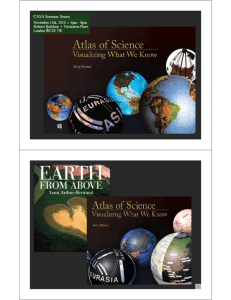

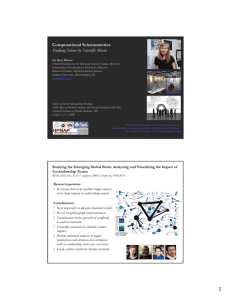
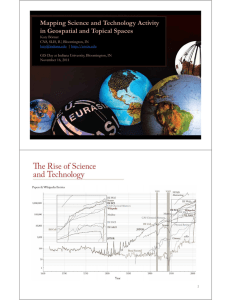
![Science Maps Explore New Ways of Displaying Information [Slide Show]](http://s2.studylib.net/store/data/010768709_1-3220b04c018450634153c8bae5b4b731-300x300.png)

